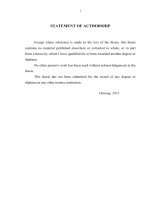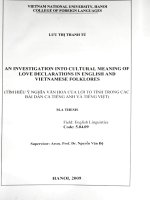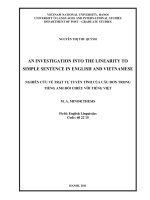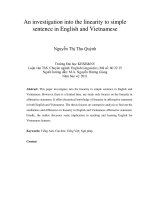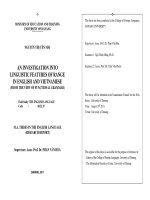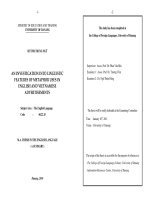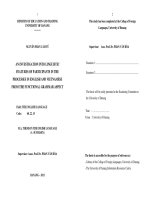An investigation into linguistic features of metaphor uses in english and vietnamese advertisements
Bạn đang xem bản rút gọn của tài liệu. Xem và tải ngay bản đầy đủ của tài liệu tại đây (122.94 KB, 13 trang )
-1-
-2-
MINISTRY OF EDUCATION AND TRAINING
UNIVERSITY OF DANANG
The study has been completed at
the College of Foreign Languages, University of Danang
HUỲNH TRUNG NGỮ
Supervisor: Assoc. Prof. Dr. Phan Văn Hòa
AN INVESTIGATION INTO LINGUISTIC
FEATURES OF METAPHOR USES IN
ENGLISH AND VIETNAMESE
ADVERTISEMENTS
Subject Area : The English Language
Code
:
Examiner 1: Assoc. Prof. Dr. Trương Viên
Examiner 2: Dr. Ngũ Thiện Hùng
The thesis will be orally defended at the Examining Committee
60.22.15
Time : January 16th, 2011
Venue : University of Danang
M.A. THESIS IN THE ENGLISH LANGUAGE
(A SUMMARY)
The origin of the thesis is accessible for the purpose of reference at:
- The College of Foreign Languages Library, University of Danang
- Information Resources Centre, University of Danang
Danang, 2010
-3CHAPTER 1
INTRODUCTION
1.1. RATIONALE
Metaphor is an outstanding linguistic phenomenon in
-41.2.2. Objectives of the study
- To describe the semantic and lexical choice features of the
metaphorical expressions
- To contrast these features in English and Vietnamese to find out the
language at present and it is concerned by many linguists. They pay
similarities and differences between two languages
much attention to metaphor because they would like to find out its
- To suggest some implications of the findings for teaching and
real nature in communication. In fact, more and more people have
learning English and Vietnamese as foreign languages, especially in
used metaphor effectively.
teaching translation
Metaphor is, at present, not considered only as rhetoric in
literature and poetry; on the other hand, it is used pervasively and
1.3. SCOPE OF THE STUDY
This study will observe and describe some commonly used
turns up in different fields relating to language and communication.
metaphors in English and Vietnamese
advertisements. The
Due to metaphor’s effectiveness and importance in practice, there are
metaphorical expressions will be analyzed in semantic and lexical
many learners and linguists have cared and studied it. Recently there
aspects basing on cognitive view.
has been a field which metaphor is used more and more; that is
Within the limit of the study, both spoken and written forms
advertising. Why is metaphor used more and more in advertisements?
of advertisements in English and Vietnamese are taken into
That is an interesting question making me curious. And, so far hardly
consideration. The data for study is based on the English and
has there been any full study on this field. That is reason why I
Vietnamese advertisements collected from products, on television, on
choose the topic “An Investigation into Linguistic Features of
websites, on radio, in newspapers, magazines, posters, etc.
Metaphor Uses in English and Vietnamese Advertisements” for my
1.4. RESEARCH QUESTIONS
study.
1.2. AIMS AND OBJECTIVES
1.2.1. Aims of the study
- To understand more about metaphor and its uses in advertisements
- To find out the possible differences and similarities in terms of the
semantic and lexical choice features of the metaphorical expressions
in English and Vietnamese
- To improve knowledge and effective use of metaphor in
advertisements, translation, and communication in general
1. What are the semantic features of the metaphorical expressions
used in English and Vietnamese Advertisements?
2. What are the lexical features of the metaphorical expressions
used in English and Vietnamese Advertisements?
3. What are similarities and differences in using metaphor in
English and Vietnamese Advertisements?
1.5. SIGNIFICANCE OF THE STUDY
The aim of the research is to study on the semantic and lexical
features of the metaphorical expressions in advertisements; therefore,
-5-
-6-
the study will be sure to provide useful information and knowledge to
In Vietnam, there are many traditional linguists that have
help the use of metaphor in advertisements as well as in cross-cultural
their own viewpoints on metaphor. For example, Đinh Trọng Lạc
communication better.
[20] studied the process of Retoric and Metaphor; Hữu Đạt [7] in
1.6. ORGANIZATION OF THE STUDY
“Phong cách học và phong cách chức năng Tiếng Việt” refered to
Chapter 1, Introduction, consists of rationale, aims and
objectives, scope of study, research questions and organization of study.
Chapter 2, Literature and theoretical background, provides a
brief literature review and theoretical background for the matters of study.
Chapter 3, Research design and methodology, presents research
method, hypotheses and procedure of data collection and analysis.
Metaphor all of kinds; Nguyễn Đức Tồn [32] in the article “Để giúp
thêm cho việc day khái niệm ẩn dụ” gave his own definition about
metaphor; Phan Văn Hòa [12] talked about “Metaphor and
grammatical metaphor”, and so forth.
2.2. THEORETICAL BACKGROUND
2.2.1. Rhetoric
Chapter 4, Findings and discussion, discusses in the result of the
Rhetoric is a branch of general linguistics which is regarded
data analysis, then gives similarities and differences of the semantic and
as a language science. It deals with the results of act of
lexical features of metaphorical expressions in advertisements.
communication [56]. It means that Rhetoric takes into consideration
Chapter 5, Conclusion
CHAPTER 2
LITERATURE REVIEW AND THEORETICAL BACKGROUND
2.1. REVIEW OF PREVIOUS STUDIES
In the Western countries, Richards [67] proposed the
alternative view that the meaning of a metaphor is the product of “an
interaction” between the meanings of the vehicle and tenor. Max
Black [43] took metaphor as a prediction whose expression is a
of the “output of the act of communication”.
2.2.2. Metaphor
Definition
Up to now, a lot of linguists and researchers have given out a
variety of definitions on metaphor. And, here are the selected
definitions on metaphor which are the closest to its nature.
“Metaphor can be defined as the mapping of one conceptual
domain onto a dissimilar conceptual domain.” [60]
sentence. George Lakoff and Mark Tuner acted for contemporary
“Ẩn dụ là phép thay thế tên gọi của sự vật, hiện tượng này
theory of metaphors. They point out that “the word has come to mean
bằng tên gọi của sự vật, hiện tượng khác loại dựa trên cơ sở liên
across domain mapping in the conceptual system”. In their research,
tưởng ñồng nhất hóa chúng theo ñặc ñiểm, thuộc tính nào ñó cùng có
they also mention some basic semantic concepts that are
ở chúng”. [32]
According to I.A Richards [67], a metaphor is composed of
two main parts: the tenor and the vehicle. The tenor is the implied
idea or the hidden subject of the comparison; the vehicle is the
metaphorical and identify a number of “basic conceptual metaphors”
that pervade discourse in Western culture.
-7metaphorical word(s) or image(s) by which the tenor is conveyed.
These two parts are combined together basing on the common ground
between them. For example:
“All the world's a stage,
And all the men and women merely players
They have their exits and their entrances.”
(William Shakespeare)
2.2.3. Conceptual metaphor
2.2.3.1. Definition
In studies of metaphor, the representation of any coherent
segment of experience, such as the concepts of love or journeys, a
conceptual domain that is understood in terms of another is called a
conceptual metaphor.
In other words, in the cognitive linguistic view, metaphor is
defined as understanding one conceptual domain in terms of another
conceptual domain. Examples of this include when we talk and think
about life in terms of journeys, about arguments in terms of wars,
about love also in terms of journeys, about theories in terms of
buildings, about ideas in terms of food, about social organizations in
terms of plants, and many others. A convenient shorthand way of
capturing this view of metaphor is the following: CONCEPTUAL
DOMAIN (A) is CONCEPTUAL DOMAIN (B), which is what is
called a conceptual metaphor. This idea, and a detailed examination
of the underlying processes, was first extensively explored by George
Lakoff and Mark Johnson in “Metaphors We Live By”. Cognitive
scientists often study subjects similar to conceptual metaphor under
the label of “analogy”. For example:
o Life is a journey.
o
Argument is a war.
-82.2.3.2. Mappings
A mapping is the systematic set of correspondences that exist
between constituent elements of the source and the target domain.
Many elements of target concepts come from source domains and are
not preexisting. To know a conceptual metaphor is to know the set of
mappings that applies to a given source-target pairing.
We can see that the set of concept in which words and
expressions is borrowed is called “Source Model”, while the concept
which is the borrowers is called “Target Model” as shown in the
examples.
Source Model
Target Model
[JOURNEY]
[LIFE]
Traveler
She went through life with a good heart.
Destinations
He knows where he is going in life.
Routes
I don’t know which path to take.
Impediments to travel
He worked his way around many obstacles.
2.2.3.3. Parts of Metaphor
A conceptual metaphor consists of two conceptual domains.
The conceptual domain from which we draw metaphorical
expressions to understand another conceptual domain is called the
source domain, while the conceptual domain that is understood this
way is the target domain [59].
2.2.3.4. Functions of Metaphor
Scholars, e.g., Fainsilber or Ortony, have found out three
reasons why metaphors are used. First, there is the so-called
inexpressibility hypothesis. That means that metaphors are used for
expressions that are not easy to explain with literal language. This
refers mostly to abstract ideas. The second reason is called
-9-
-10-
compactness hypothesis. This hypothesis says that people can
categorize those things that normally do not have such a boundary by
express ideas more detailed and compact with metaphors. The last
using those entities. We set up artificial boundaries.
hypothesis, called vividness hypothesis, says that by metaphors,
expressions are made clearer and livened up.
2.2.3.5. Classification of Metaphors
Lakoff and Johnson divided the metaphorical concepts into
three groups which are presented as follows:
a. Structural metaphors
There are many kinds of ontological metaphors with different
purposes one of them being the concept abstracts are things:
o
a series of questions
o
The world is full of art.
Another concept is the container metaphors. According to
Lakoff and Johnson, human beings are containers with boundaries
The group of structural metaphors is said to be the biggest
and an orientation of inside and outside. This orientation is also
group. Different parts of experiences which are complex but too
used for other physical objects. But also non-physical objects (e.g.
abstract are conceptualised with the help of simple but known
events, actions, activities, states) can be understood by transforming
experiences, e.g. the example DISCUSSION IS WAR.
them into physical objects with definite boundaries.
o
a rhetorical fought out battle
o
a guerrilla warfare of words
In these examples, one tries to explain the abstract concept
In the case of activities, states, and emotions that could
mean: He fell in love.
We will be out of the trouble soon.
discussion with the help of the concrete concept war and typical
The problem will be dealt with in the next discussion.
words which are linked to it.
A very important group of ontological metaphors is those
b. Orientational metaphors
Another group is the orientational metaphors. Those
that describe something as a person, a personification. There are
innumerable examples like:
metaphors are based on the orientation in space. Therefore, a spatial
o
This theory explains everything.
relationship is made for a concept. This relationship is normally
o
The facts are against it.
based on our experiences of the physical space we have examples:
BEING HAPPY IS UP/BEING SAD IS DOWN
c. Ontological metaphors
2.2.3.6. Metaphor versus Simile and Metonymy
a. Metaphor versus Simile
Metaphor and simile are the two of the best known stylistic
The last group, the ontological metaphors, is based on the
devices. Simile in English and Vietnamese is a comparison between
experience with physical objects. Those experiences can be identified
two different things that resemble each other in at least one way.
and categorized as entities restricted by a surface. So we can
Here are some examples to illustrate:
I see men, but they look like trees, walking. [38]
-11Đẹp như tiên. [7]
-122.2.5.2. Types of Metaphors used in Advertising
b. Metaphor versus Metonymy
According to Forceville’s work, he has divided metaphors in
As in the case of the contemporary theory of metaphor,
advertising into three types: verbal metaphors, pictorial metaphors,
Lakoff and Johnson’s work entitled Metaphors We Live By gives the
and a combination of images and words. Within the study, the writer
issue of the usage of metonymy. Lakoff and Johnson defined
only focuses on verbal metaphors.
metonymy as “using one entity to refer to another that is related to it”
[59]. Following are some examples:
o
He’s in dance
o
The Times hasn’t arrived at the press conference yet.
CHAPTER 3
METHODS AND PROCEDURES
3.1. RESEARCH DESIGN
Combining descriptive and qualitative methods of study, the
2.2.4. Advertising
paper will treat the common uses of metaphor in use in the two
2.2.4.1. Definition of Advertising
languages. Accordingly, chapter 4 of the paper will collect and
A definition given by Cook, G. states: “Advertising means
classify in terms of metaphor, namely the use of metaphor in
clearly identifiable, paid for communications in the media, which
advertisements available in both English and Vietnamese. The paper
aims to persuade, inform, or sell. But the world is also used to cover
will systematically enumerate lexical choice and analyze semantic
a much broader range of activities – from design to public relations –
features of these specific uses of metaphor which is largely based on
by what are often the same organizations, using similar skills.” [47]
the association of similarities of entities concerned.
2.2.4.2. The Aims of Advertising
Besides, differences, similarities, and points of contrast
2.2.4.3. Functions of Advertising
between the two languages will be pinpointed.
2.2.4.4. Classification of Advertising
3.2. RESEARCH METHOD
2.2.4.5. Typical Features of Advertising Language Viewed from
The study is carried out under a contrastive analysis. Here,
Psychological Perspective.
both English and Vietnamese are used as the source and target
2.2.5. Metaphor in Advertising
language so that we can find out contrastive information from a
2.2.5.1. Roles of Metaphor in Advertising
bilateral approach.
Leiss, Kline, and Jhally have used metaphor to study social
communication in advertising.
They suggest that metaphors in
3.3. RESEARCH PROCEDURE
3.3.1. Collecting and classifying data
advertisements have become a powerful and commonly used strategy.
The data for analysis are the samples taken from English and
“Metaphor is the very heart of the basic communication form used in
Vietnamese advertisements on different channels if possible. About
advertising” [64].
500 advertisements both English and Vietnamese will be collected.
-13-
-14-
The major method to collect data is to survey with the observation of
Hat Council: If you want to get
ahead, get a hat
Địa ốc SaigonLand: Điểm hẹn
của sự thành công!
Pampers: We’re right behind you.
Every step of the way
FPT: Cùng ñi tới thành công
metaphorical expressions in English in comparison with those
After all, can you think of a better
way to avoid manual labour? Sabura
equivalents in Vietnamese.
You're invited on a Journey
Trường Nhân lực Quốc tế: Vững
bước ñến tương lai!
Con ñường tốt nhất vào Đai học
hàng ñầu thế giới.
instances of linguistic expressions used to signal metaphors.
3.3.2. Analyzing data
The steps will be carried out here as follows:
Presenting,
describing,
and
analyzing
the
types
of
CHAPTER 4
DISCUSSION OF FINDINGS
4.1.
CONCEPTUAL
METAPHORS
IN
ENGLISH
4.1.1.2. Wars
AND
VIETNAMESE ADVERTISEMENTS
Some of examples to illustrate the war/fight conceptual
metaphor as follows:
4.1.1. Semantic Features of Metaphorical Expressions in English
and Vietnamese
[78]
You Can Kill a Horse but not a Cadillac
[79]
Milmax Angle 2 với Lactoferrin: Lá chắn vững chắc cho
Through advertisements, we can see both English and
thiên thần của bạn
Vietnamese advertisers conceptualize domains in advertisements in
terms of [JOURNEY], [WAR], [FASHION], [SECRET], etc.
Quaker Puffed Rice: Shot from Guns!
Clear: Trong thế giới của tóc, gàu bắt ñầu xâm chiếm [113]
Table 4.2. Metaphorical expressions belong to the source model
4.1.1.1. Journeys
[WAR] in English and in Vietnamese
Let’s come to see the following examples:
English
SABURA: After all, can you think of a better way to avoid
manual labour? SABURA
[38]
Budweiser Beer: Nothing beats a
Coca-Cola ... along the highway to anywhere.
[80]
Budweiser
Địa ốc SaigonLand: Điểm hẹn của sự thành công!
[38]
“Con ñường tốt nhất vào Đai học hàng ñầu thế giới.” [107]
Table 4.1. Metaphorical expressions belong to the source model
[JOURNEY] in English and in Vietnamese
English
Blue Ginger Restaurant: A nice
place to come
[38]
Vietnamese
Anh văn Hội Việt Mỹ: Khởi ñầu
cho sự thành công
Vietnamese
Milmax Angle 2 với Lactoferrin:
Lá chắn vững chắc cho thiên
thần của bạn
Quaker Puffed Rice: Shot from
Kem Nivea Q10 Plus: Đẩy lùi
Guns!
mọi dấu hiệu lão hóa
You Can Kill a Horse but not a
Kem ñánh răng P/S: Bảo vệ hôm
Cadillac
nay, chắc khỏe ngày mai
Prudential Financial: Growing and
Thật xứng danh thủ lĩnh Plasma
protecting your wealth
siêu việt
-15-
-16-
Nicorette: Nicorette, Nicorette, you
Clear: “Trong thế giới của tóc,
Doral Cigarettes: Taste Me! Taste Me! Come on and Taste
can beat the cigarette
gàu bắt ñầu xâm chiếm…”
Me!
[78]
Lifebuoy: So, doesn’t it make sense to try new lifebuoy? [9]
4.1.1.3. Friends
The shown examples in English and Vietnamese:
Tide: Hãy thưởng thức mùi hương buổi sớm và ánh nắng
COX Communications: Your Friend in the Digital Age [78]
ban mai của Tide
[38]
Thái Sơn-người bạn trung thành và chuyên nghiệp của bạn
Dầu nhớt ENEOS: Đừng ñể xe bạn ăn tạp.
[9]
4.1.1.5. Healthcare
[98]
Người Lao Động – Tờ báo luôn ñồng hành với ñời sống và
Let’s have a look at some examples:
việc làm của bạn
Candy – Refrigerator: Fresh food and fresh air. The perfect
[99]
Table 4.3. Metaphorical expressions belong to the source model
recipe for a healthy life. I’ve chosen. It’s Candy
[38]
[FRIEND] in English and in Vietnamese
Club Med resorts: The antidote for civilization.
[78]
Sức khỏe mỗi ngày, hạnh phúc bền lâu
[38]
English
IZUSU: Always besides you
Transcend (USB): Digital life in
your hand. Your supplier, Your
partner, Your friend
Kodak: Share moments. Share life
Pampers: We’re right behind you.
Every step of the way
Access: Your Flexible Friend
Vietnamese
Bảo Việt Việt Nam: Cùng bạn
trên mọi nẻo ñường
Sữa Ensure Gold: Vì sức khỏe vàng của người thân yêu [38]
4.1.1.6. Light
The light metaphor turns up in English and in Vietnamese:
Thái Sơn – người bạn trung
Kiwi Shoe Polish: When your shoes shine, so do you
[38]
thành và chuyên nghiệp của bạn
C'mon Colman's, light my fire
[76]
+
Bảo hiểm Prudential: Luôn luôn
lắng nghe, luôn luôn thấu hiểu
Người lao ñộng – Tờ báo luôn
ñồng hành với ñời sống và việc
làm của bạn.
Hãy chọn kỳ nghỉ tuyệt vời cho
bạn cùng Hàng không Singapore.
4.1.1.4. Food
Take some advertisements for example:
Enfa Grow A : Bé học giỏi hơn, tương lai sáng hơn
[76]
Hãy ñể Missha “thắp sáng vẻ ñẹp” của bạn
[76]
4.1.1.7. Fashions
The structural mapping between the target model and the
source model [FASHION] is the same in both languages:
Fila: Functional … Fashionable … Formidable
[38]
Siemens: Designed For Life
[38]
Ford Focus S: Phong cách mới, ñầy cá tính
[9]
Honda Spacy: Đậm phong cách. Thật thời trang. Rất thịnh
hành
4.1.1.8. Gifts
[38]
-17-
-18-
The following is some examples:
4.1.1.12. Keys
Kleenex: Thank goodness for Kleenex
[38]
Here are some examples in English and in Vietnamese:
Arpege perfume: Promise her anything, but give her
IBM: e-business Solutions
[78]
Arpege!
Cadillac: a new measure of automotive supremacy
[79]
Sacombank: Chìa khóa mở cửa thành công
[38]
Vitanol: Giải pháp trị gàu mới
[38]
[82]
This mapping is more common and explicit than in Vietnamese:
Nước khoáng thiên nhiên Thạch Bích: Quà tặng vô giá của
thời gian
[38]
4.1.1.13. Containers
“Sự quan tâm chăm sóc ân cần, những bài thuốc an toàn
hiệu quả là những món quà tinh thần quý giá…”
[104]
The following examples are linguistic realizations of this
metaphor:
4.1.1.9. Secrets
Vauxhall: Put the Fun Back Into Driving
Let’s have look at the following examples both in English
[78]
Tic Tacs: Put a Tic Tac in your mouth and get a bang out of
and Vietnamese:
life.
[83]
Busch Gardens: Where Discover Is a Real Adventure
[38]
Nước khoáng Wells: Mang thiên nhiên vào cuộc sống [38]
Dầu gội PANTENE: Chính bạn là người khám phá
[38]
Table 4.9. Metaphorical expressions belong to the source model
Biore: Chúng ta hãy cùng khám phá Biore nhé
[9]
[CONTAINER] in English and in Vietnamese
4.1.1.10. Magic
English
Vietnamese
Colgate: The world leader in oral
Nước khoáng Wells: Mang thiên
care
nhiên vào cuộc sống
Lipton Tea: Lipton’s gets into
DellTM: Cùng DellTM thành công
Touch of Sweden: Could your hands use a small miracle?
more hot water than anything
hơn trong kinh doanh.
[38]
Vauxhall: Put the Fun Back Into
Kem dưỡng da Nivea: Vẻ ñẹp tự
Driving
nhiên ñầy sức sống
Here, the advertising language is presented in terms of magic.
Heineken Beer: Hãy ñắm say nét ñẹp Phương Đông huyền
bí và một sức hút “HÀ LAN” mãnh liệt
Enchanteuer: Phép màu huyền diệu của tình yêu
[38]
[103]
4.1.1.11. Persons
Commercial Union Insurance: We
Here are some examples:
Jaguar: Born to Perform
[38]
Seiko: It works, sleeps, wakes up, and goes to work
[38]
Kem Acnes: Thật hiểu làn da
[38]
Diana Ultra M – Nuông chiều siêu con gái.
[105]
won't make a drama out of a
crisis
“Để tránh rơi vào tình trạng
stress, bạn nên ăn uống ñâyg ñủ
dưỡng chất hay ñơn giản them một
viên Berocca vào buổi sáng.”
Access Credit Card: Access takes
“Căn hộ chất lượng cao – mức giá
the waiting out of wanting
trong tầm tay.”
-19-
-20-
4.1.1.14. Entities
4.1.1.16. Precious
Let’s have a look at the following examples:
Here the source model [PRECIOUS] is used to depict and
Mercedes: The pursuit for perfection has no finish line. [38]
Shure: Pure soul. Pure vision. All me
[38]
Sữa Ensure Gold: Vì sức khỏe vàng của người thân yêu [38]
Bia Đại Việt: Bia của những khát khao
[38]
Đại tiệc vàng mừng sinh nhật vàng lần thứ 11
[102]
Du học Hàn Quốc: Tầm nhìn mới, tương lai mới
[38]
Cơ hội vàng ñể ñầu tư.
[102]
4.1.1.15. Up-down schema
From these above examples, we recognize that “significant”
Some examples for illustration:
is conceptualized as “precious” through the metaphorical expressions
Sandals: Sandals – the small heel steps up in status
[38]
“vàng”. The source model is only found in Vietnamese.
The Times: Top people take the Times
[76]
4.1.1.17. Ideas
Sữa tắm Romano: Khẳng ñịnh ñẳng cấp phái mạnh
[38]
Mì Gấu ñỏ: Đỉnh cao của chất lượng
[38]
Table 4.10. Metaphorical expressions belong to the source model
[UP-DOWN] in English and in Vietnamese
English
Vietnamese
Colgate: The world leader in oral
care
Bounty
emphasize the crucial importance of products and services:
Towels:
The
Quicker
Picker-Upper
[IDEA] is merely seen in English.
Panasonic: For pure living, Ideas for life
[38]
Northern Telecom: Technology the world calls on
[38]
Senior Service cigarettes: A product of the master mind [76]
4.1.1.18. Summary
“…cùng vươn tới ñỉnh cao.”
Bia Saigòn: Có thể bạn không cao
nhưng người khác cũng phải ngước
nhìn
Sandals: Sandals – the small heel
Sữa tắm Romano: Khẳng ñịnh ñẳng
steps up in status
cấp phái mạnh
Budweiser: The King of Beers
Contrary to the source model [PRECIOUS], the model
Mì Gấu ñỏ: Đỉnh cao của chất
lượng
Accenture: High Performance,
Khu ñô thị cao cấp Hưng Phú:
Delivered.
Nâng cao giá trị cuộc sống
4.1.2. Lexical Features of Metaphorical Expressions in English
and Vietnamese
4.1.2.1. Metaphor Nouns
Metaphor nouns functioning as subjects:
Peugeot: The Lion Leaps from Strength to Strength
[78]
EGLO ñèn nội và ngoại thất: Ánh sáng là cuộc sống
[38]
Metaphor nouns functioning as objects:
Red Bull: It Gives You Wings.
[78]
Enfa Mama: Hãy nhớ, bạn ñang mang trong mình một mầm
sống yêu thương, một sinh linh quí giá của cuộc ñời.
Metaphor nouns function as objects of prepositions:
[38]
-21Bounty: A Taste of Paradise
[78]
“Trước những tai nạn bất ngờ xảy ra cho laptop...” [107]
Metaphor nouns are used as compliments:
Budweiser: The King of Beers
[78]
“Nhân sâm là món quà vô giá mà tạo hóa ñã ban tặng cho
con người…”
[104]
4.1.2.2. Summary
4.1.2.3. Metaphor Verbs
Metaphor verbs function as predicatives:
Nestcafé: Awaken your senses
[38]
Sacombank: Ươm mầm cho những ước mơ
[38]
Metaphor verbs function as objects:
Clear: Trong thế giới của tóc, gàu bắt ñầu xâm chiếm [113]
Dầu nhớt ENEOS: Đừng ñể xe bạn ăn tạp.
[9]
4.1.2.4. Summary
4.1.2.5. Metaphor Advjectives
Metaphor adjectives fuction as predicatives:
Strand cigarettes: You're never alone with a Strand.
[77]
MiLo: Thức uống dinh dưỡng giàu năng lượng
[38]
Metaphor adjectives function as attributives:
AT & T Telecommunications: Smart phone smarts
[38]
+
Enfa Grow A : Bé học giỏi hơn, tương lai sáng hơn
[38]
4.1.2.6. Summary
4.1.2.7. Metaphor Prepositions
Beside these traditional metaphors, prepositions can also be
used as metaphors. The following is some examples:
Pampers: We’re right behind you. Every step of the way [38]
Lux: “…ñắm mình trong hương thơm quyến rũ của Lux. [38]
Căn hộ chất lượng cao – mức giá trong tầm tay.
[107]
4.1.2.8. Summary
-22From the findings, discuss, and analysis above, we can see
that English and Vietnamese share the similarities in using metaphor
nouns, verbs, adjectives, and prepositions in advertising language.
Among kinds of these metaphors, metaphor nouns are used most
productively and most commonly.
4.2.
CONCEPTUAL
METAPHORS
ARE
USED
MOST
COMMONLY IN ENGLISH AND VIETNAMESE
4.2.1. Conceptual Metaphors are Used most Commonly in English
From the samples studied, we find that all three types of
conceptual metaphors are used in advertising via different source
models, but their frequency is not the same. The statistics are shown
in the table 4.13 below:
Table 4.13. Frequency of occurrence of types of conceptual
metaphors in English
Type of metaphor
Quantity
Percentage
Structural metaphors
116
46.4%
Ontological metaphors
119
47.6 %
Orientational metaphors
15
6%
Total
250
100.00
6%
Structural metaphors
46%
48%
Ontological metaphors
Orientational metaphors
Figure 4.1. Frequency of occurrence of types of conceptual
metaphors in English
-23-
-24-
With the percentage 47%, the Ontological metaphors are, in
CHAPTER 5
fact, used most in English.
CONCLUSION AND IMPLICATIONS
4.2.2. Conceptual Metaphors are used most Commonly in Vietnamese
5.1. CONCLUSION
While the Ontological metaphors are used most commonly in
Generally, this study has carried out on the basis of the
English, the Structural metaphors are most employed in Vietnamese
Conceptual Metaphor Theory established by cognitive linguists
as shown in the table 4.14 below.
Lakoff and Johnson and focused on the conceptual metaphors that are
Table 4.14. Frequency of occurrence of types of conceptual
used in advertising language in English and Vietnamese. Also, within
metaphors in Vietnamese
this study, the semantic and lexical choice features of the conceptual
Type of metaphor
metaphors are examined.
Quantity
Percentage
Structural metaphors
171
68.4%
With the findings and analysis, the study has found the
Ontological metaphors
67
26.8%
clearest answers to the research questions. The author has dealt with
Orientational metaphors
12
4.8%
the sematic and lexical choice features of metaphors by showing
Total
250
100.00
examples and analyzing these examples specifically and thoroughly in
the cognitive view to meet the aims and objectives mentioned in the
5%
chapter 1.
Structural metapho rs
27%
As what we have found, discussed, and analysed above, we
Onto lo gical metapho rs
can see that advertising language both English and Vietnamese has
Orientatio nal metapho rs
shared most common features about semantics and lexical choices.
68%
From the findings and discussion, we realize that conceptual
Figure 4.2. Frequency of occurrence of types of conceptual metaphors in
metaphors play an important role in advertising. The advertisers have
Vietnamese
taken the advantage of metaphor’s high meaning transference to serve
4.2.3. Summary
their advertising aims. As a result, the advertisers have used
In general, although there are differences in terms of the
metaphors in advertisements in order to make advertising language
frequency of occurrence of conceptual metaphors in English and
more exciting, interesting, lively, and persuasive with the aim at
Vietnamese, linguistic features are almost analogous in two
drawing the consumers’ attention, persuading them to buy their
languages.
products and services as many as possible.
Although there are some differences about the conceptual
domains used metaphorically and lexical choices in advertising
-25between two languages: English and Vietnamese, which is not much,
-265.2.3. For Advertisers
these two languages almost share similarities in semantic and lexical
The study can help advertisers with important information
features. Therefore, we can come to conclusion that in the light of the
and necessary knowledge about using metaphor in advertising. From
cognitive view, conceptual metaphors always exist in advertising in
the knowledge caught, they can apply into designing and writing
both English and Vietnamese and are an indispensable part of modern
advertising slogans and advertisements effectively. The advertisers
life.
can use metaphors in advertisements to arouse consumers’ attention
5.2. FURTHER IMPLICATIONS FOR TEACHING AND
and persuade them to buy products and services as much as possible.
LEARNING CONCERNING THE USE OF METAPHORICAL
5.3. LIMITATION OF THE THESIS
EXPRESSIONS
5.2.1. For Foreign Language Learners
The paper is carried out on the basis of the limited data
source. In spite of personal efforts, the analysis is not clear here and
The result of the study is maybe beneficial to learners of both
there. With limited and personal ability, some weaknesses are
languages. The contrastive analysis will offer them a clearer insight
inevitable. I would be very grateful to those that take interest in the
into metaphor uses. Moreover, the study helps learners enrich their
topic and work. Any comment, advice, and adjustment are very
knowledge about conceptual metaphors in the conceptual metaphor
valuable to make this paper more fulfilled, clearer, and more perfect.
theory (CMT). With comprehension of the mappings between two
5.4. SUGGESTIONS FOR FURTHER RESEARCH
the conceptual domains based on CMT: the source domain and the
This study has been carried out to analyze the similarities and
target domain, this helps students conceptualize and recall linguistic
differences in semantic and lexical choice features of metaphor uses
expressions better than the traditional ones. It is that helps students
in English and Vietnamese advertisements, but it is only small part,
write and translate better.
not the whole because of limited time and ability. If I had enough
5.2.2. For Foreign Language Teachers
such conditions, I might finish my ambition. So, I would like to
This thesis maybe help teachers have deeper insight into the
suggest some further reseaches on the following aspects:
the contrastive analysis between English and Vietnamese in terms of
metaphor. The study provides teachers with the additional source that
- Metaphorical expressions should be seen in pragmatics and
syntax.
is necessary in meeting students’ studying needs. As the whole, with
- Metaphor verbs should be paid more attention.
further knowledge, Teachers can encourage their students to learn
- Cross-culture studies of metaphor in advertising should be
and perceive language through practising and applying metaphor.
studied.
- Metaphorical expressions in advertising should be analyzed
on other data sources.
